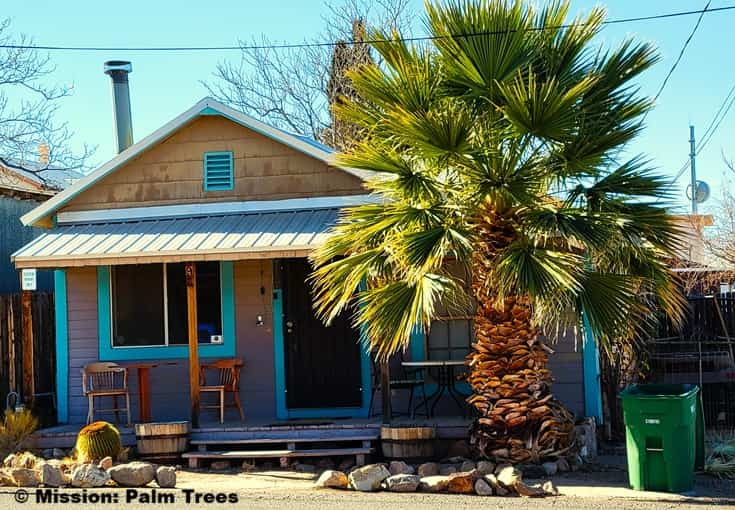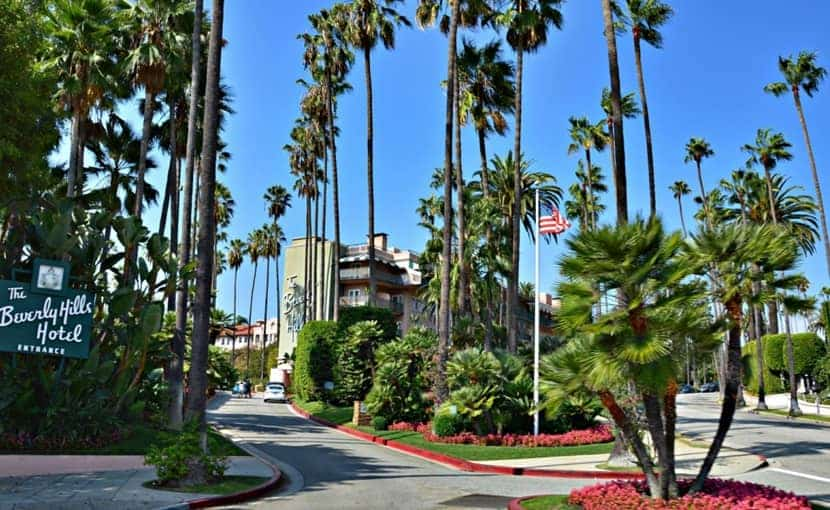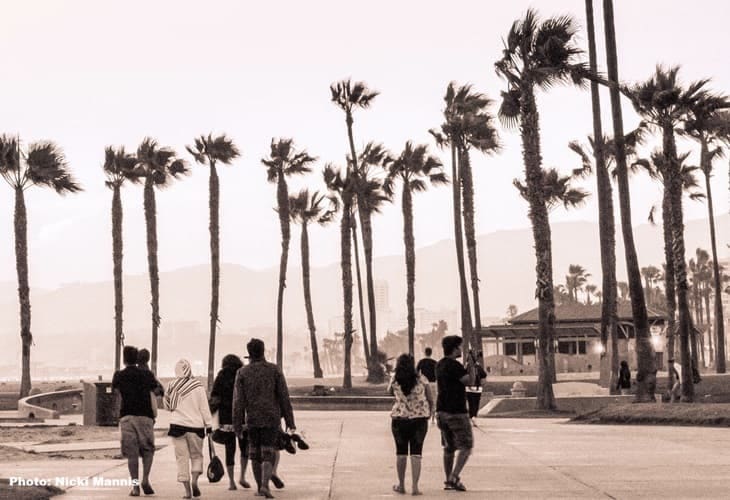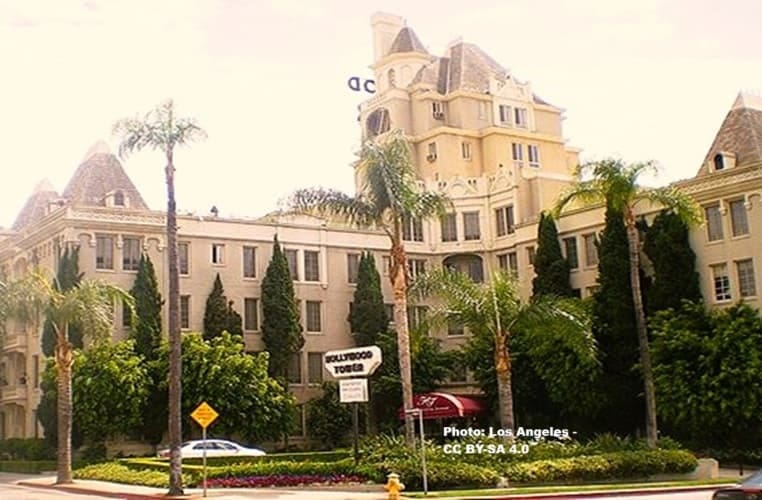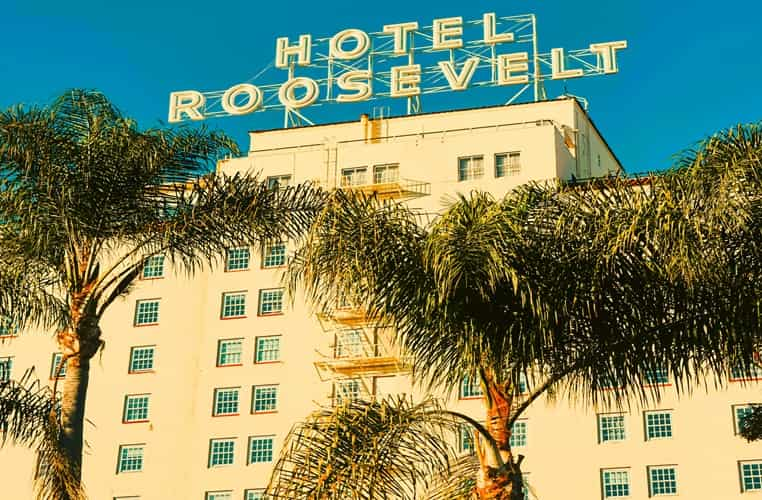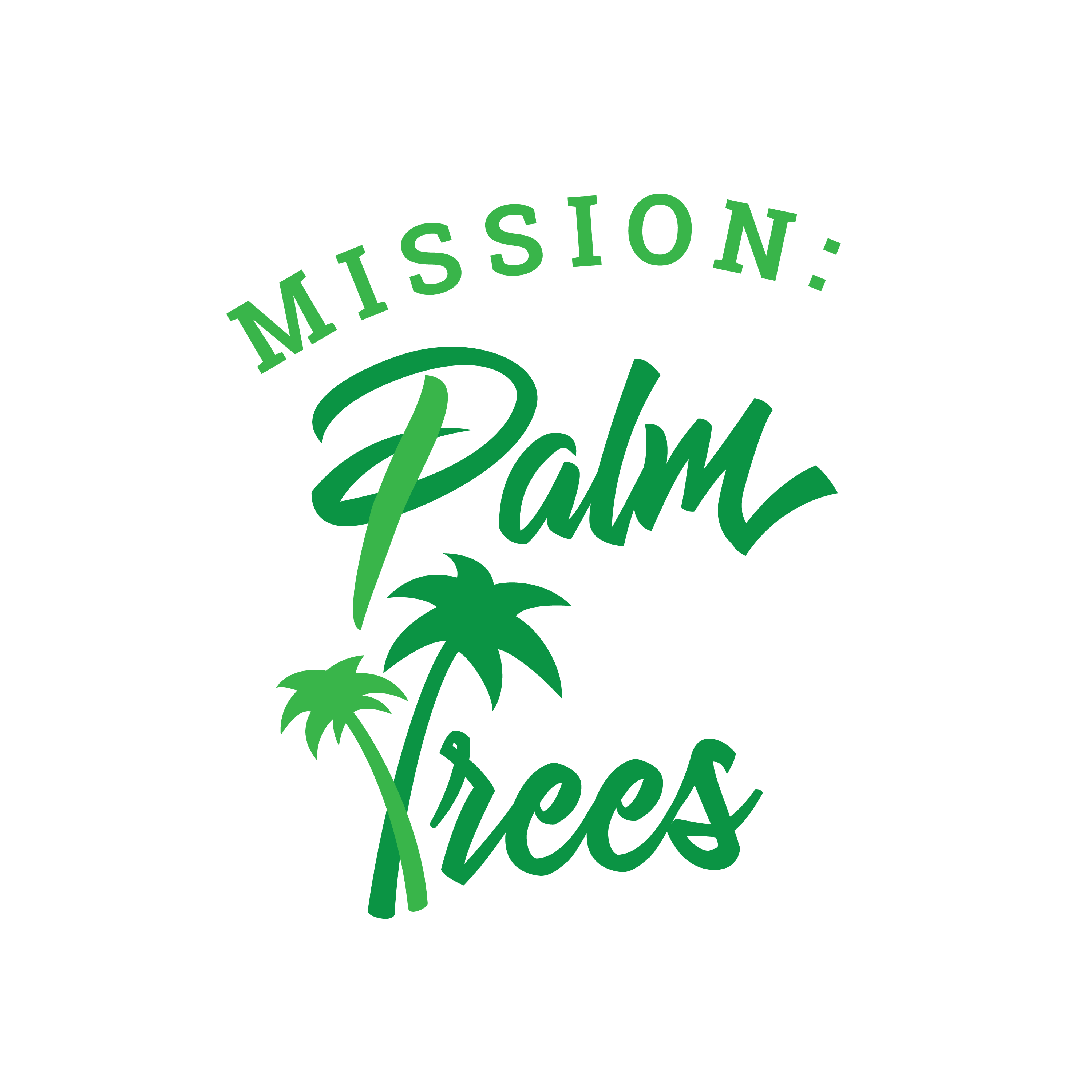- Home
- Palms in U.S.
- Palms of California
- Palms in LA
Palm Trees in Los Angeles
An Iconic Symbol of the City
Thinking of palm trees in Los Angeles, tall palms probably come to mind.
You've probably seen photos of the city's palms standing tall against the sunny Southern California skyline. They've become established LA symbols. They represent the area's dreamy blend of culture and history.
- Have you ever wondered about their origins? The history of palm trees in LA.
- Have you ever wondered if they're native, or is that just fiction?
- Have you ever wondered how their mythic status came to be?
We lived in SoCal for ten-plus years. So we can take you through the fascinating beginning of palm trees in Los Angeles that we came to know. And go into how they became a part of the city's identity.
Take this journey to uncover the roots of these palms, and what they signify in this bustling metropolis.
History of Palm Trees in Los Angeles
From the early days of Hollywood's flashiness to the diverse neighborhoods that define the city today, palm trees had taken root in the heart of Los Angeles.
- The history of palm trees in California is as entrancing as the palms themselves.
- Only one palm is native to California. Surprising to many who associate these majestic plants with the state's sunny vistas.
- Pioneering botanists, climate, and their cultural significance have all contributed to the presence of palms lining Los Angeles streets.
In the 1990s, a city's count of palms reported about 75,000. Mostly they're old ones, now enduring senescence (biology term for old age).
Feeling overwhelmed by so many palm trees?
You're not alone. We Understand your headaches! At Mission: Palm Trees you'll find clear answers to questions & Step-By-Step Guidance, from real people. With solutions to help. No puzzling shoptalk. No tiring research. So it's easy & fun for you.
The Beautifying Origins of Palm Trees in LA
To see when and why non-native palms were first planted, let's go back in time to the 18th century.
Early Spanish missionaries introduced palm trees into California. They'd brought seeds of the date palm (Phoenix dactylifera) from Mediterranean regions. It was easily adapted to the Californian climate.
That event set the stage for trying out more palm species.
Into the 19th & 20th centuries, Palms Became a Symbol of Southern California. Early settlers saw their appeal and developers began planting them.
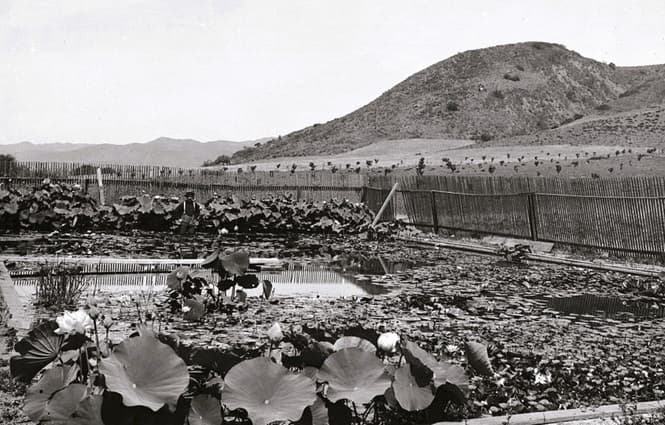 Sturdiva-Garden on Franklin Ave in newly developing Hollywood -1920
Sturdiva-Garden on Franklin Ave in newly developing Hollywood -1920The Washingtonia robusta (Mexican Fan Palm) became particularly popular.
Its sky-scraping height and sunset silhouette made it perfect for beautifying streets and parks.
 Group of Mexican Fan Palms in a Pacific coastal park.
Group of Mexican Fan Palms in a Pacific coastal park.The love affair between Los Angeles and palm trees really kicked off during the Hollywood boom of the 1920s and 1930s.
- Palms became the focal part of the Hollywood image. Reflecting dreams of those who flocked to Los Angeles in search of opportunity and fame.
- They appeared in countless films & advertisements.
- Postcards were designed to show palms as the emblem of cultural and economic zest of Southern California.
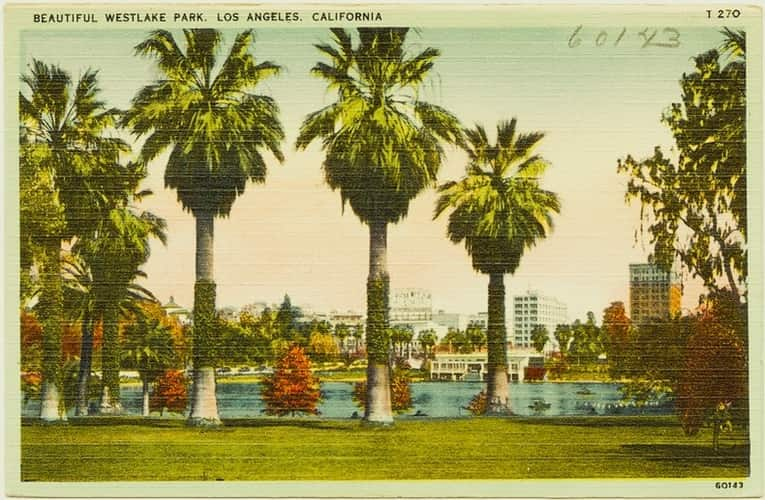 Vintage Los Angeles postcard - with W. filifera palms.
Vintage Los Angeles postcard - with W. filifera palms.Palm Trees Had a Role in the 1932 Olympics
Palm trees spread through Los Angeles largely from efforts before the 1932 Olympics.
In the 1920s and early 1930s, the city launched a massive tree-planting program, adding around 40,000 palm trees. The intent was to create an exotic, tropical image that would appeal to tourists and Olympic visitors.
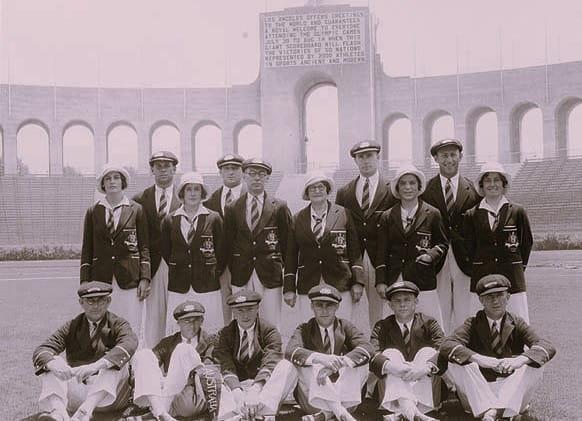 Australian Team poses in Olympic Stadium in 1932 Los Angeles.
Australian Team poses in Olympic Stadium in 1932 Los Angeles.The Mexican Fan Palm was chosen because it was low-maintenance and grew quickly.
The city planted them to create the "paradise" aura that LA wanted to project to the world. It became fantastic publicity for promoting the city's Mediterranean climate and lifestyle during the Olympics and beyond.
Palm Trees Continued as a Symbol of the City
FTC Disclosure: If you purchase via a link/ ad on this site, we may earn a small royalty. There's no added cost to you. Thanks much for any looks/ orders! Details>
If you've visited, you wouldn't have missed how palm trees have a unique place in Los Angeles' urban landscape.
You'd See Them Downtown, in City Parks and residential areas. For that tropical aesthetic.
That raced ahead when city planners and developers found that locals and visitors noticed them more and more. They decided they would bring a distinctive visual identity for the city. They started becoming synonymous with Los Angeles.
They strategically planted them to enhance that vibe. Especially in Identifying Neighborhoods (Think Beverly Hills), commercial districts, and Tourist Destinations Like the LA Zoo.
As Los Angeles expanded, so did the variety and number of palm trees. Whether swaying gently in the breeze or standing tall against a sunset, palm trees have since been part of the city's landscape.
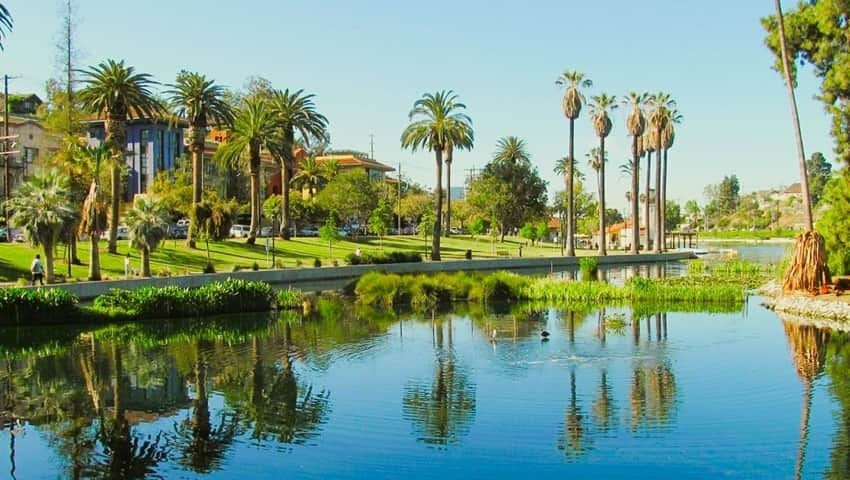 Echo Park in Los Angeles is adjacent to Dodger Stadium.
Echo Park in Los Angeles is adjacent to Dodger Stadium.Palm Trees as a Symbol of Hollywood
and the California Dream
The image of palm-lined streets and sun-drenched boulevards has been ingrained in popular culture.
Palms represent an idealized vision of the California lifestyle. With warm, sunny weather, sandy beaches and glamorous people.
That popular culture association is seen in countless films, television shows, and advertisements. This symbolism is potent in Hollywood. Palms seem to capture the glitz and glamour of the entertainment industry.
Palms Showcase Los Angeles Areas, to encourage you to join in this exciting, ritzy, desirable destination.
The Cultural Significance of Palm Trees in Los Angeles
Palm trees are connected to cultural significance in Los Angeles. They still symbolize the allure and promise of Southern California.
- They present a sense of escapism and paradise.
- They present a reminder of the city's sunny disposition and laid-back lifestyle.
- They present feelings of aspiration: the dream of success and relaxation that Los Angeles promises.
Palm trees have also become a symbol of resilience and adaptability, mirroring the city's diverse population and dynamic culture.
- Just as palm trees grow in varied climates, Los Angeles is a Melting Pot of Different Cultures, lifestyles, and ambitions.
- Just as heirlooms tell stories family of resilience through generations, palm trees still stand through Los Angeles' transformations, showing their unshakeable character.
- Just as master chefs create exceptional dishes from available ingredients, palms show how Los Angeles takes challenging conditions and transforms them into growth and beauty.
You yourself, can stay in one of these multicultural Los Angeles Experiences:
- Chinatown's Restaurants and Exciting Encounters>
- At the Waterfront, Relax Near Little Italy>
- Enjoy Boyle Heights, nearby Little Mexico>
- Little Ethiopia is Less Than 1/2-mile Away>
These neighborhoods and activities have become a fundamental part of the cultural fabric of Los Angeles.
Get Some Insider Looks at LA's Famed Autos!
Diverse Palm Species Elevate LA’s Landscape
Los Angeles boasts a rich diversity of palm tree species, each contributing to the city's unique Botanical Tapestry With a Place to Stay.
Let's see the most common palms you'll see if you visit Los Angeles.
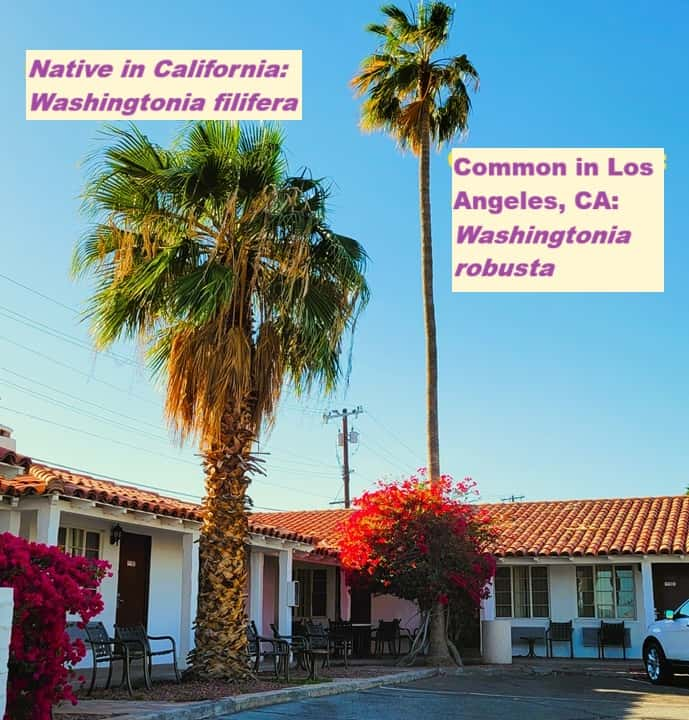 Photo copyright: © Mission: Palm Trees
Photo copyright: © Mission: Palm TreesMexican Fan Palm
The Mexican Fan Palm (Washingtonia robusta) is perhaps the most classic palm tree in Los Angeles.
Known for its impressive height, it often reaches up to 100 feet. Its slender trunk and fan-shaped leaves are unmistakable as the palm trees in Los Angeles.
This species is particularly valued for its resiliency in urban planting.
- With the ability to thrive in various soil conditions.
- With the ability to resist drought conditions.
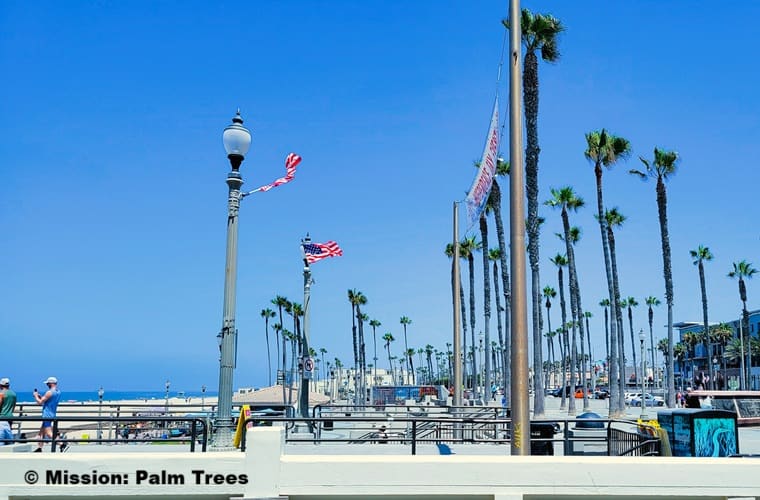 And with the ability to tolerate seaside salty air and sandy soil. That's W. robusta!
And with the ability to tolerate seaside salty air and sandy soil. That's W. robusta!The Versatile California Fan Palm
Washingtonia filifera is the only palm species native to California.
Originally found at natural springs and desert oases (Find Your Own Oasis Stay>), but now incorporated into urban landscapes. Like Los Angeles (natively a desert!), and where we live - Tucson Arizona. With its ability to withstand desert climates and extreme temperatures.
This palm is shorter and stockier than the Mexican Fan Palm. Though it has the same fan-shaped leaves.
Canary Island Palm Tree
Another notable palm species in LA, the Canary Island Date Palm (Phoenix canariensis) is stately. With a sturdy diamond-like patterned trunk and feathery fronds.
Originating in the Canary Islands (Start Planning Your Vacay Stays There - so many choices!), it's easily grown in many other places. Because it's not very fussy for soil, heat/cold, and water - once established.
A favored choice among SoCal landscape designers and homeowners.
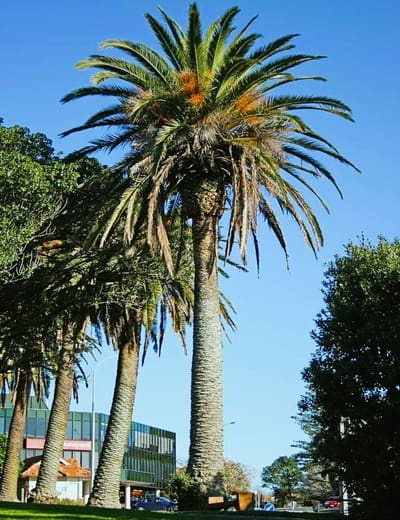 Beautiful full crown on the Canary Island Palm
Beautiful full crown on the Canary Island PalmThe Most Common Types of Palm Trees in Los Angeles
Those most well-known species above, are most common types of palms in LA. But along with those are a few others:
- Like the Queen Palm (Syagrus romanzoffiana)
- Like the Date Palm (Phoenix dactylifera)
All these and more present a varied palm population throughout Los Angeles.
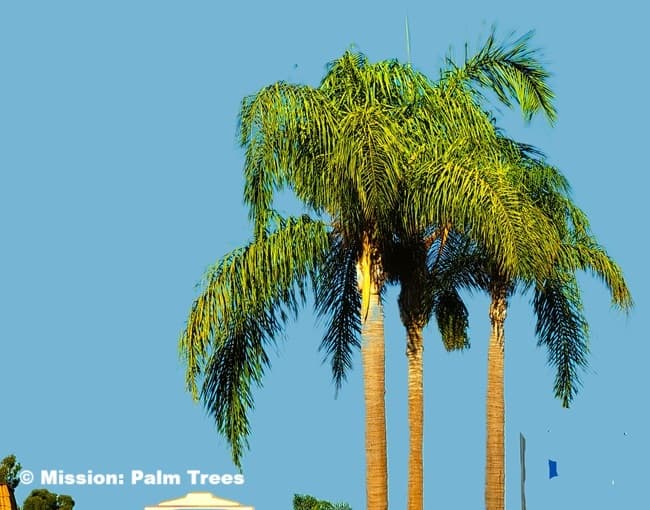 From a feathery topical look - water it well!
From a feathery topical look - water it well!The Magniicent Queen
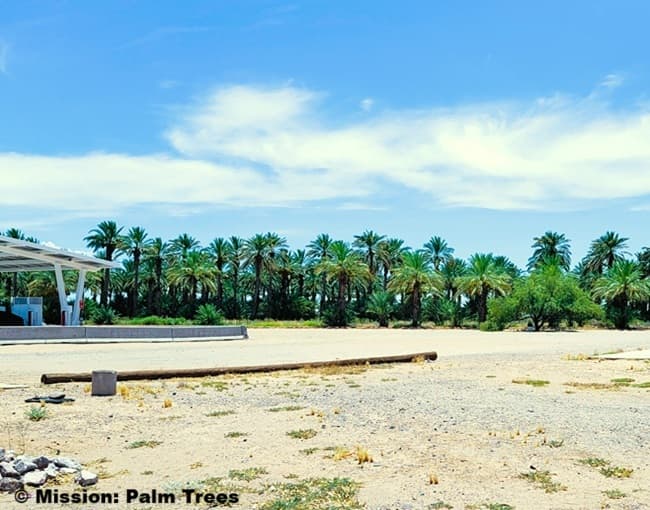 To drought-hardy palms - don't overwater them!
To drought-hardy palms - don't overwater them!Waiting on the Ripening Dates
Where to See the Most Impressive Palm Trees in LA
Some areas are well-known for their enchanting boulevards lined with palms.
Fronting distinctive areas, like homes of the rich & famous, historic avenues, or along the Pacific Ocean. Take a look at which you'll be sure not to miss when Taking a Los Angeles Vacation!
Beverly Hills' Famous Palm-Lined Streets
You'll get Vibes of That Rich, Famed Appeal in the Picture-Perfect Setting That is Beverly Hills. Surrounded by LA, it's central to all you'd want to see & do.
The City of Beverly Hills Takes Them Seriously! Take a walk on those palm-lined streets and you'll have photo-worthy scenes of palms that suits its vibe. Situated along the hills, you may capture fabulous Pacific viewpoints.
Have you dreamed of being there? Why not Stay in This Famous Town? You can do it!
You can find Many Places to Stay, From Budget Beverly Pricing to High-End Like the Famous!
Venice Beach Boardwalk
Venice Beach and its famed boardwalk isn't far from Beverly Hills. About 10 miles.
Sunset Boulevard's Palm Collection: A Living Landmark
The iconic image associated with Los Angeles is that long line of towering palm trees.
But nowhere is that more vivid than Along Sunset Boulevard, the Place to Stay! They're a living landmark, planted with that beautification project. To create a Mediterranean-like oasis. Some are over 80 feet tall, looking stunning!
The "Sunset Boulevard Palm Collection" stretches from Hollywood Through Echo Park (stays are here). With especially picturesque stretches in Beverly Hills, Hollywood (Places to Stay) and in West Hollywood (Places to Stay).
As these palms near their lifespan's end, the city debates what to do about their future.
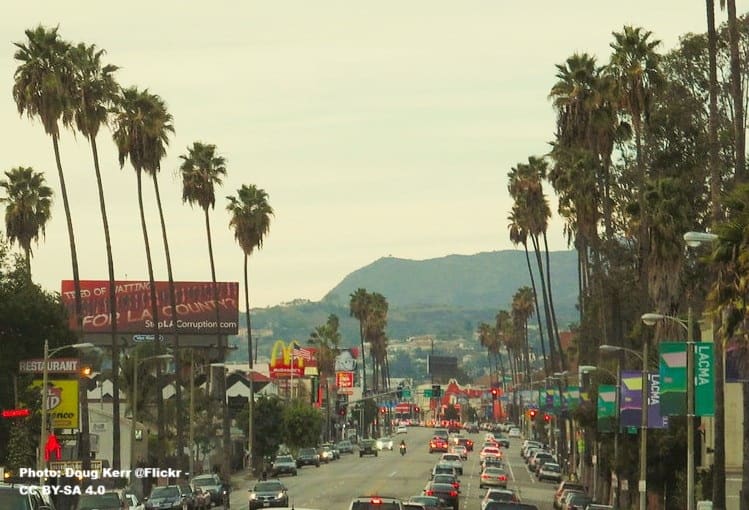 A View Along Sunset Boulevard in Los Angeles, California
A View Along Sunset Boulevard in Los Angeles, CaliforniaCheck Out This Different, But Very Cool Way to See The Los Angeles Area
And All its Tall Palm Trees!
Hollywood's Historic Palm Locations
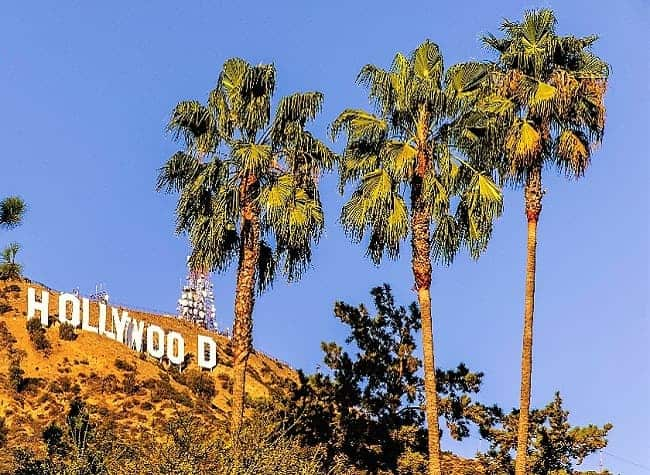 One is in front of the famed "Hollywood Sign."
One is in front of the famed "Hollywood Sign."Take your own pic from S. Windsor Blvd., between 4th & 5th.
Other places to get great pics of palms in Hollywood:
- In front of the Hollywood Tower Apartments.
- On the grounds of the historic Hollywood Roosevelt Hotel on Hollywood Boulevard.
- The El Capitan Theatre, famed for hosting premiers with the stars attending.
 El Capitan Theatre - Home to Blockbuster Movie Premiers for the Stars
El Capitan Theatre - Home to Blockbuster Movie Premiers for the Stars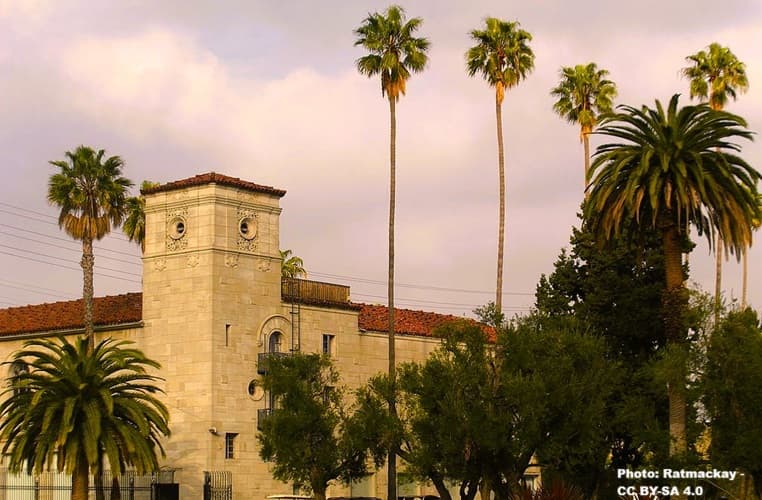 Hollywood Forever Cemetery - Main Building Surrounded by Tall Palms
Hollywood Forever Cemetery - Main Building Surrounded by Tall PalmsThe Benefits and Drawbacks of Palm Trees
in Urban Environments Like LA
Palm trees, most agree, are aesthetically pleasing.
Yet they do have an impact on local Los Angeles ecosystems.
- They have altered natural ecological balances.
- This affects native plant species and wildlife.
- Mostly because they crowd out native vegetation.
Non-native palm trees compete with local plants for water, sunlight, and soil nutrients. Palms become steadfast in using these resources, which creates a struggle for native plants.
Yet think about these palms, having some benefits for Los Angeles urban wildlife:
- Some species provide dense leaf crowns, helping nesting birds
- They provide food sources for bird species, insects, and small mammals.
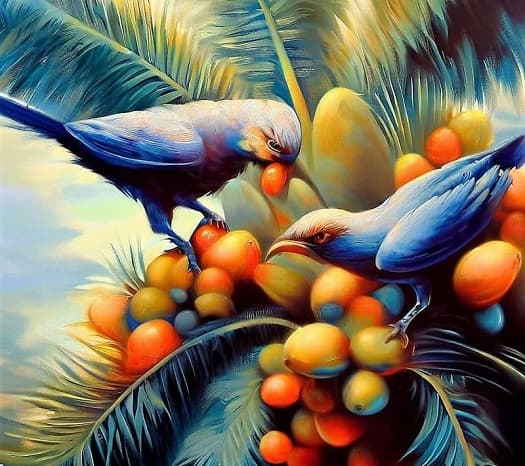
Debating the Environmental Impact of Palm Trees
So we see there are benefits and challenges for palms.
- Some Angelinos love them.
- Some Angelinos hate them.
They contribute to urban green spaces with some air purification and oxygen contribution. But palm maintenance and care use major city resources, like water, pruning, and pest control.
Palm trees can interrupt infrastructure. Like sidewalks & utility lines. Plus their height makes them a lightning rod. Leading to fires in this dry environment.
And the impact of climate change is a concern.
- Increasing temperatures and lengthy droughts lead to extended fire seasons. Long droughts can stress palms. Then they're more vulnerable to pests and diseases.
- Water availability diminishes because of drought. Maintenance and care for palms then become increasingly difficult.
For a healthy LA urban ecosystem their ecological footprint must be considered. Efforts are in place for balance, ensuring that palms coexist with native plants and wildlife.
The Future of Palm Trees in Los Angeles
Palm trees in Los Angeles will need to be included in urban development projects to keep their famed status and cultural significance.
- In residential areas, palms often contribute to property values and neighborhood desirability.
- Commercial districts and tourist destinations also benefit from their presence.
A balanced, strategic placement of palms in Los Angeles is a need for the city's urban design. City reps knows this. They're developing a proportional plan.
Conservation Efforts and Initiatives
There are additional challenges for palm trees in Los Angeles.
Inevitable construction can disrupt palm root systems and their current habitats. Road & sidewalk expansion, plus utility line installation invade spaces occupied by palms. Some palms can't be easily relocated. Then it's just easier and cheaper on the city budget to eliminate them.
Balancing the preservation of palms with city growth is complicated and ongoing. Because of palms' importance to the city's identity and heritage, protection and support for palm trees in Los Angeles continue.
Many organizations and community groups are dedicated to help.
- The Los Angeles Urban Forestry Division. They oversee care and management of palms across the city.
- Community efforts involve residents and local groups in planting, educational programs, and advocacy campaigns. Raising awareness about the importance of palm trees in LA.
Sustainable plant management practices are a consequential part of Los Angeles landscapes. Cooperation between government agencies, non-profits, and citizens is essential for successful preservation initiatives.
Takeaways for Palm Trees in Los Angeles
We palm lovers are often fascinated by the palm trees in Los Angeles California.
The future of palms in the city is intertwined with the city’s growth and environmental sustainability. As Los Angeles evolves, the role of palms remains important. As cultural icons, environmental beautification and community assets. Ongoing cooperative efforts play a key role.
We've seen how palm trees are symbols of Los Angeles’ identity, history, and aspirations. That's a continuing story.
